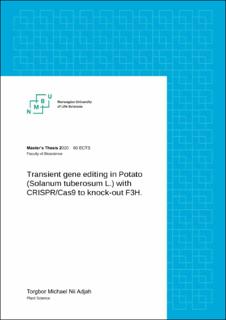| dc.contributor.advisor | Hvoslef- Eide, Trine | |
| dc.contributor.advisor | Wulff-Vester, Anders | |
| dc.contributor.author | Torgbor, Michael Nii Adjah | |
| dc.date.accessioned | 2021-01-31T16:22:22Z | |
| dc.date.available | 2021-01-31T16:22:22Z | |
| dc.date.issued | 2020 | |
| dc.identifier.uri | https://hdl.handle.net/11250/2725445 | |
| dc.description.abstract | With the continuous desire for crops with superior qualities, the CRISPR/Cas9 gene editing system seems to be a promising, cost-effective, efficient and a much faster method of developing new superior varieties compared to other gene editing and conventional breeding methods. The introduction of gene editing methods, where CRISPR is one of these, has proven to be a game changer in the discussions on GMOs’ around the world. The determination and optimization of the transformation methods with higher transformation efficiencies and precise transient gene
expression without the addition of foreign genetic material can be compared to mutation breeding methods used for the past 100 years. However, mutation breeding induces random mutations whiles gene editing tools are relatively more precise. When no foreign DNA is added, these methods can be compared biologically, and this is vital for the consideration of whether the resulting plant should be considered a GMO or not.
As a proof-of-concept for the use of CRISPR in potato, this projects aims at knocking-out the flavanone-3-hydroxylase (F3H) gene in the anthocyanin pathway of the new red-skin potato variety ‘Nansen’ for the possible outcome of a yellow-skinned coloured potato. The biolistic transformation techniques (using DNA plasmid and callus) and PEG-mediated transformation methods (using ribonucleoprotein (RNP) and protoplasts) were employed to determine the best method suited for further gene editing applications with ‘Nansen’.
Dual guide DNA and RNP were used for gene knock-out in this project. Different polyethylene glycol (PEG) concentrations (25% and 40%) were tested to determine their effect on transformation efficiency. In the determination of the suitable induction and regeneration media to employ for the biolistic transformation, morphological variations were observed based on media composition as well as the condition of growth. The methods used could not be assessed to determine a suitable protocol for future transformations in ‘Nansen’ by the end of the project due to severe contaminations of the protoplast cultures and eventually the Corona pandemic with the close-down of the laboratory for students. However, based on previous published studies, both methods seem promising with more regenerated transgene-free plants when ribonucleoproteins with synthetically produced RNA guides (cr-RNP)
are used compared to DNA. | en_US |
| dc.language.iso | eng | en_US |
| dc.publisher | Norwegian University of Life Sciences, Ås | en_US |
| dc.rights | Attribution-NonCommercial-NoDerivatives 4.0 Internasjonal | * |
| dc.rights.uri | http://creativecommons.org/licenses/by-nc-nd/4.0/deed.no | * |
| dc.subject | Plant biotechnology | en_US |
| dc.subject | Gene editing | en_US |
| dc.subject | Potato | en_US |
| dc.title | Transient gene editing in Potato (Solanum tuberosum L.) with CRISPR/Cas9 to knock-out F3H | en_US |
| dc.type | Master thesis | en_US |
| dc.subject.nsi | VDP::Agriculture and fishery disciplines: 900 | en_US |
| dc.description.localcode | M-PV | en_US |

